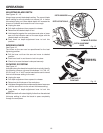
14
Fig. 7
To lessen the chance of kickback, follow these safety
practices:
Keep the blade at the correct depth setting. The depth
setting should not exceed 1/4 in. below the material being
cut.
Inspect the workpiece for knots or nails before cutting.
Never saw into a knot or nail.
Make straight cuts. Always use a straight edge guide
when rip cutting. This helps prevent twisting the blade.
Use clean, sharp, and properly set blades. Never make
cuts with dull blades.
Support the workpiece properly before beginning a cut.
Use steady, even pressure when making a cut. Never
force a cut.
Do not cut warped or wet lumber.
Hold the saw firmly with both hands and keep your body
in a balanced position so as to resist the forces if kickback
should occur.
WARNING:
When using the saw, always stay alert and
exercise control. Do not remove the saw from
the workpiece while the blade is moving.
SAW BLADES
The best of saw blades will not cut efficiently if they are not
kept clean, sharp, and properly set. Using a dull blade will
place a heavy load on the saw and increase the danger of
kickback. Keep extra blades on hand so that sharp blades
are always available.
Gum and wood pitch hardened on blades will slow the
saw down. Remove saw blade from the saw and use gum
and pitch remover, hot water, or kerosene to remove these
accumulations. DO NOT USE GASOLINE.
BLADE GUARD SYSTEM
See Figure 8.
The lower blade guard attached to the circular saw is there
for your protection and safety. Do not alter it for any reason.
If it becomes damaged, do not operate the saw until you
have the guard repaired or replaced. Always leave guard in
operating position when using the saw.
DANGER:
When sawing through work, lower blade guard
does not cover blade on the underside of work.
Since blade is exposed on underside of work, keep
hands and fingers away from cutting area. Any part
of your body coming in contact with moving blade
will result in serious injury.
OPERATION
Fig. 8
CAUTION:
To avoid possible serious injury, never use saw
when guard is not operating correctly. Check the
guard for correct operation before each use. The
guard is operating correctly when it moves freely,
and instantly returns to the closed position. If you
drop the saw, check the lower blade guard and
bumper for damage at all depth settings before
reuse.
If at any time the lower blade guard does not snap closed,
unplug the saw from the power supply. Exercise the lower
guard by moving it rapidly back and forth from the full open
position to the closed position several times. Normally this
will restore the guard to its normal operating condition. If
it does not correct a slow or sluggish closing lower guard,
do not use the saw. Take it to an authorized factory service
center for repair.
CORRECT SUPPORT
LOWER BLADE GUARD IS IN UP
POSITION WHEN MAKING A CUT


















